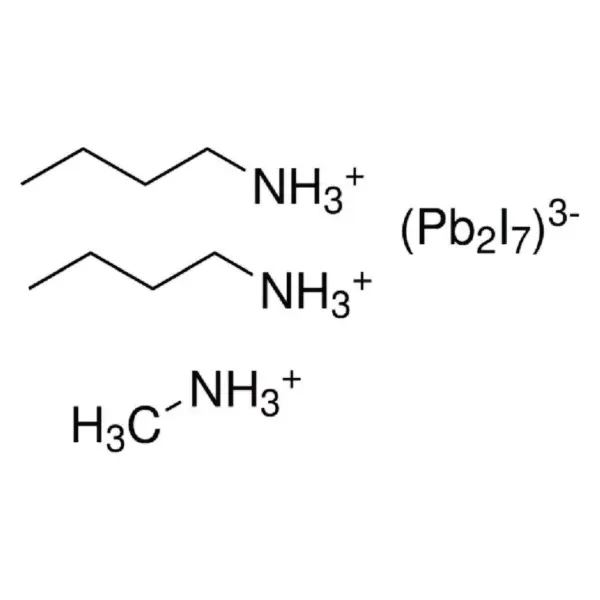
dATP Solution – 25 umol
RM0.00Brand:
New England Biolabs
Enhance your PCR Reaction with our ultrapure dATP solution
- Compatible with all NEB DNA polymerases in a variety of applications
- ≥ 99% purity as determined by HPLC analysis
- Also available in solution mix (NEB #N0447) or set (NEB #N0446) format
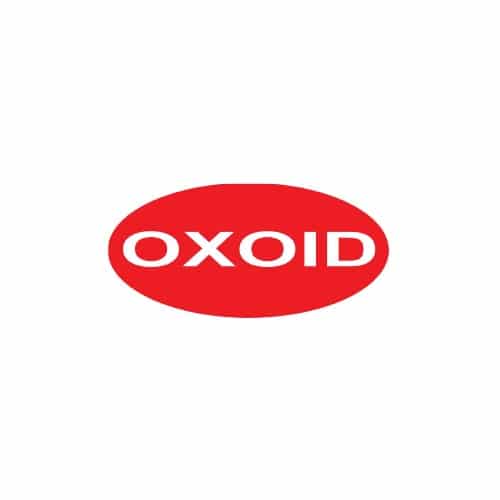
Defibrinated Horse Blood (100ML)
RM0.00Brand:
Thermo ScientificTM OxoidTM
Thermo Scientific™ Oxoid Defibrinated Horse Blood is a blood product.
**This product is not available at the moment.

Defibrinated Horse Blood (25ML)
RM0.00Brand:
Thermo ScientificTM OxoidTM
Thermo Scientific™ Oxoid Defibrinated Horse Blood is a blood product.
**This product is not available at the moment.

Defibrinated Sheep Blood (25ML)
RM0.00Brand:
Thermo ScientificTM OxoidTM
Thermo Scientific™ Oxoid Defibrinated Sheep Blood is a blood product.
**This product is not available at the moment.
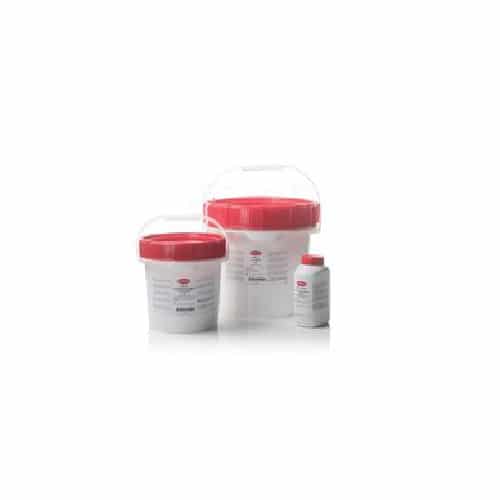
Dehydrated Rogosa Agar 500g
RM491.00Brand:
Thermo ScientificTM OxoidTM
Oxoid Rogosa Agar is used for the selective isolation and enumeration of lactobacilli.
Rogosa Agar, Oxoid Composition
| Typical Formula* |
gm/litre |
| Tryptone |
10.0 |
| Yeast extract |
5.0 |
| Glucose |
20.0 |
| Sorbitan mono-oleate `Tween 80’ |
1.0ml |
| Potassium dihydrogen phosphate |
6.0 |
| Ammonium citrate |
2.0 |
| Sodium acetate, anhydrous |
17.0 |
| Magnesium sulphate |
0.575 |
| Manganese sulphate |
0.12 |
| Ferrous sulphate |
0.034 |
| Agar |
20.0 |
| pH 5.4 ± 0.2 @ 25°C |
Rogosa Agar, Oxoid Preparation:
Suspend 82g in 1 litre of distilled water and bring to the boil to dissolve completely. Add 1.32ml glacial acetic acid and mix thoroughly. Heat to 90-100°C for 2-3 minutes with frequent agitation. Distribute into sterile tubes, Petri dishes or bottles.
DO NOT AUTOCLAVE.
Storage conditions and Shelf life
Store the dehydrated medium at 10-30°C and use before the expiry date on the label.
Store the prepared medium at 2-8°C.
Precautions
Lactobacillus carnis does not grow on this medium.
All colonies must be tested by Gram stain and catalase test before carrying out further identification tests.
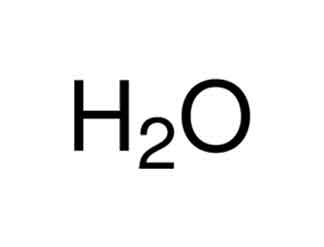
Deionized Water
RM360.00Brand:
MP Biomedicals
WATER, DNase, RNase-Free, is designed for those critical applications where DNase and RNase contamination can be serious problems. Research use only. Key application include reconstitution of lyophilized products and washing solution.
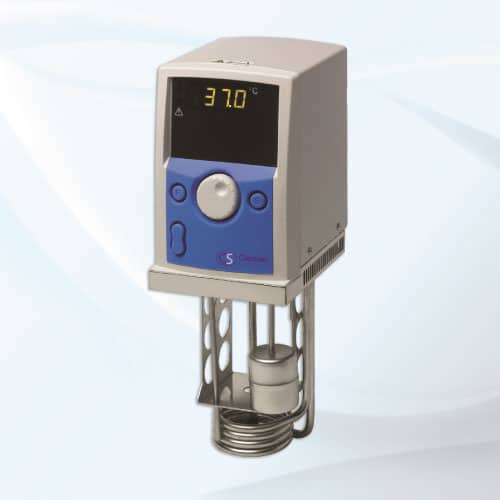
Denaturing Gradient Electrophoresis Temperature Control Unit
RM0.00Brand:
Cleaver Scientific
The redesigned VS20DGGETC temperature control unit combines buffer recirculation with a heat sensor and 1.4kW heating element to facilitate precise temperature control to within 0.02C, allowing the gel temperature to be set to the melting temperature (Tm) of the amplified DNA polymorphism or mutation of interest. Other benefits include; a conspicuous 4-digit 16mm LED panel to aid set-up, precise tuning to within 0.1C resolution, an operating set point, plus three adjustable pre-set temperature values, and stirred buffer circulation for temperature stability and uniformity.
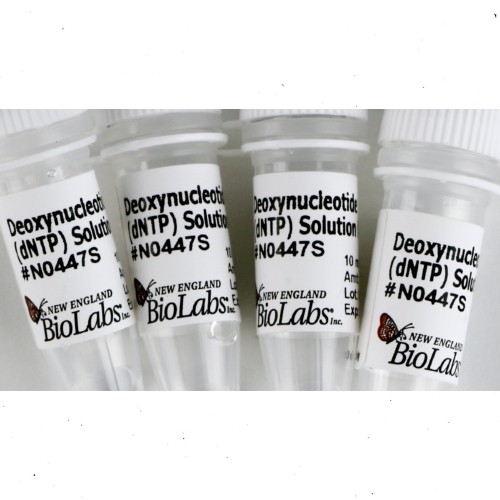
Deoxynucleotide Solution Mix (dNTP)
Brand:
New England Biolabs
Enhance your PCR Reaction with our ultrapure dNTPs
- Compatible with all NEB DNA polymerases in a variety of applications
- ≥ 99% pure as determined by HPLC analysis
- Exceptional stability

Deoxynucleotide Solution Set – 25 umol of each
RM0.00Brand:
New England Biolabs
- Enhance your PCR reaction with our ultrapure dNTPs
- Compatible with all NEB DNA polymerases in a variety of applications
- Ultrapure: ≥ 99% as determined by HPLC analysis
- Exceptional stability

Dermasel Agar Base 500g
RM693.00Brand:
Thermo ScientificTM OxoidTM
- Oxoid Dermasel Agar Base is used for primary isolation and identification of dermatophyte fungi.
- Also available Dermasel Selective Supplement, Part No. SR0075E.
Dermasel Agar Base, Oxoid Composition
| Typical Formula* |
gm/litre |
| Mycological peptone |
10.0 |
| Glucose |
20.0 |
| Agar |
14.5 |
| pH 6.9 ± 0.2 @ 25°C |
Dermasel Agar, Oxoid Preparation:
Suspend 44.5g in 1 litre of distilled water and heat gently to dissolve completely. Add the contents of 1 vial of Dermasel Selective Supplement SR0075, reconstituted as directed in the product insert, to each 500ml of medium to give a level of cycloheximide 0.4g/l and chloramphenicol 0.05g/l. Mix gently and sterilise by autoclaving at 121°C for 10 minutes. Avoid overheating at any time.
Storage conditions and Shelf life
Store the dehydrated medium at 10-30°C and use before the expiry date on the label.
Store the prepared agar plates at 2-8°C.
Precautions
This medium should not be used if agents causing systemic mycoses are being sought9. If such agents are suspected e.g. cryptococcus, histoplasma etc., either Dermasel Agar Base without antibiotic supplement must be used in parallel or Brain Heart Infusion Agar CM0375.
If the fungal agent sought is suspected to be nutritionally fastidious, the use of Brain Heart Infusion Agar is particularly helpful.
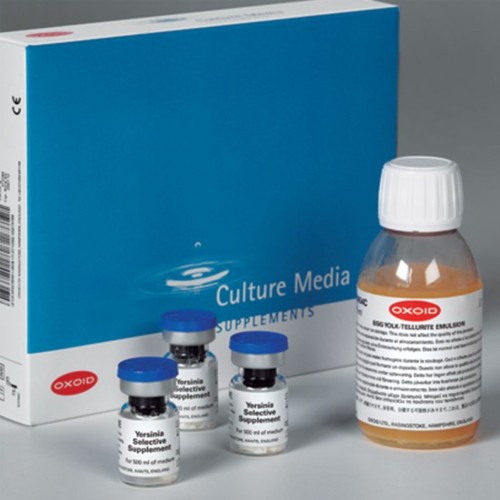
Dermasel Selective Supplement
RM1,033.00Brand:
Thermo ScientificTM OxoidTM
Oxoid Dermasel Selective Supplement is used for Dermasel Medium, Part No. CM0539B.
- Each vial supplements 500mL of medium
Dermasel Selective Supplement, Oxoid Composition
| Vial contents |
per vial
|
per litre
|
| Cycloheximide |
200mg |
400mg |
| Chloramphenicol |
25.0mg |
50.0mg |
Dermasel Agar, Oxoid Preparation:
Suspend 44.5g in 1 litre of distilled water and heat gently to dissolve completely. Add the contents of 1 vial of Dermasel Selective Supplement SR0075, reconstituted as directed in the product insert, to each 500ml of medium to give a level of cycloheximide 0.4g/l and chloramphenicol 0.05g/l. Mix gently and sterilise by autoclaving at 121°C for 10 minutes. Avoid overheating at any time.
Storage conditions and Shelf life
Store the dehydrated medium at 10-30°C and use before the expiry date on the label.
Store the prepared agar plates at 2-8°C.
Precautions
This medium should not be used if agents causing systemic mycoses are being sought9. If such agents are suspected e.g. cryptococcus, histoplasma etc., either Dermasel Agar Base without antibiotic supplement must be used in parallel or Brain Heart Infusion Agar CM0375.
If the fungal agent sought is suspected to be nutritionally fastidious, the use of Brain Heart Infusion Agar is particularly helpful.
Dermasel Selective Supplement SR0075 contains a toxic concentration of cycloheximide. Note the precautions to be taken under HAZARDS.

Desoxycholate Agar 500g
RM466.00Brand:
Thermo ScientificTM OxoidTM
Isolate, enumerate and differentiate coliforms in dairy products with differential Thermo Scientific™ Oxoid™ Desoxycholate Agar (Dehydrated). The medium is also used for the isolation of enteric pathogens from rectal swabs, feces or other specimens. Differentiation of coliforms is based on the fermentation of lactose. Lactose fermenting bacteria form pink colored colonies while non-lactose fermenters form straw colored colonies.
Desoxycholate Agar, Oxoid Composition
| Typical Formula* |
gm/litre |
| Peptone |
10.0 |
| Lactose |
10.0 |
| Sodium desoxycholate |
1.0 |
| Sodium chloride |
5.0 |
| Dipotassium hydrogen phosphate |
2.0 |
| Ferric citrate |
1.0 |
| Sodium citrate |
1.0 |
| Neutral red |
0.03 |
| Agar |
15.0 |
| pH 7.1 ± 0.2 @ 25°C |
Desoxycholate Agar, Oxoid Preparation:
Suspend 45g in 1 litre of distilled water. Bring to the boil over gauze and flame to dissolve the medium completely. Agitate to prevent charring.
THIS MEDIUM IS HEAT SENSITIVE. AVOID EXCESSIVE OR PROLONGED HEATING DURING RECONSTITUTION. DO NOT AUTOCLAVE OR REMELT.
Storage conditions and Shelf life
Store the dehydrated medium at 10-30°C and use before the expiry date on the label.
Store the prepared agar plates at 2-8°C.

Desoxycholate Citrate Agar (Hynes) 500g, Oxoid
RM894.00Brand:
Thermo ScientificTM OxoidTM
An improved medium, based on the Hynes modification of Leifsons medium for the isolation of Salmonellae and Shigellae. The improvement gives larger and more numerous colonies of Shigella species which can easily be picked off and emulsified in saline for slide agglutination tests.
Desoxycholate Citrate Agar (Hynes), Oxoid Composition
| Typical Formula* |
gm/litre |
| `Lab-Lemco’ Powder |
5.0 |
| Peptone |
5.0 |
| Lactose |
10.0 |
| Sodium citrate |
8.5 |
| Sodium thiosulphate |
5.4 |
| Ferric ammonium citrate |
1.0 |
| Sodium desoxycholate |
5.0 |
| Neutral red |
0.02 |
| Agar |
12.0 |
| pH 7.3 ± 0.2 @ 25°C |
Desoxycholate Citrate Agar (Hynes), Oxoid Preparation:
Suspend 52g in 1 litre of distilled water. Bring to the boil over gauze and flame, to dissolve completely. Agitate to prevent charring. Cool to approximately 50°C and pour into sterile Petri dishes. Dry the agar surface before use.
THIS MEDIUM IS HEAT SENSITIVE: AVOID EXCESSIVE OR PROLONGED HEATING DURING RECONSTITUTION. DO NOT AUTOCLAVE OR REMELT.
Storage conditions and Shelf life
Store the dehydrated medium at 10-30°C and use before the expiry date on the label.
Store the prepared agar plates at 2-8°C.
Precautions
The medium is best used freshly prepared.
Stock cultures of Shigella species may become predominantly in the R-phase when subcultured away from DCA media. Such cultures are difficult to use for control purposes without first heavily streaking the cultures on DCA plates and picking off the few S-phase colonies i.e. the macro-colonies on the agar surface, for further subculture.
When making biochemical tests on colonies picked from the surface of DCA plates, purity subcultures should be carried out because the colony may be contaminated with Escherichia coli present as micro-colonies.

Desoxycholate Citrate Agar 500g
RM609.00Brand:
Thermo ScientificTM OxoidTM
Oxoid Desoxycholate Citrate Agar is a differential medium for enumeration of coliforms and the isolation of enteric pathogens.
Desoxycholate Citrate Agar, Oxoid Composition
| Typical Formula* |
gm/litre |
| Lab-Lemco’ powder |
5.0 |
| Peptone |
5.0 |
| Lactose |
10.0 |
| Sodium citrate |
5.0 |
| Sodium thiosulphate |
5.0 |
| Ferric citrate |
1.0 |
| Sodium desoxycholate |
2.5 |
| Neutral red |
0.025 |
| Agar |
15.0 |
| pH 7.0 ± 0.2 |
Desoxycholate Citrate Agar, Oxoid Preparation:
Suspend 48.5g in 1 litre of distilled water. With frequent agitation bring to the boil over a gauze and flame to dissolve completely. Mix well and pour plates immediately. Dry the agar surface before use.
THIS MEDIUM IS HEAT SENSITIVE. AVOID EXCESSIVE OR PROLONGED HEATING DURING RECONSTITUTION. DO NOT AUTOCLAVE, OR REMELT.
Storage conditions and Shelf life
Store the dehydrated medium at 10-30°C and use before the expiry date on the label.
Store the prepared agar plates at 2-8°C.
Precautions
The medium is best used freshly prepared.
Stock cultures of Shigella species may become predominantly in the R-phase when subcultured away from DCA media. Such cultures are difficult to use for control purposes without first heavily streaking the cultures on DCA plates and picking off the few S-phase colonies i.e. the macro-colonies on the agar surface, for further subculture.
When making biochemical tests on colonies picked from the surface of DCA plates, purity subcultures should be carried out because the colony may be contaminated with Escherichia coli present as micro-colonies.
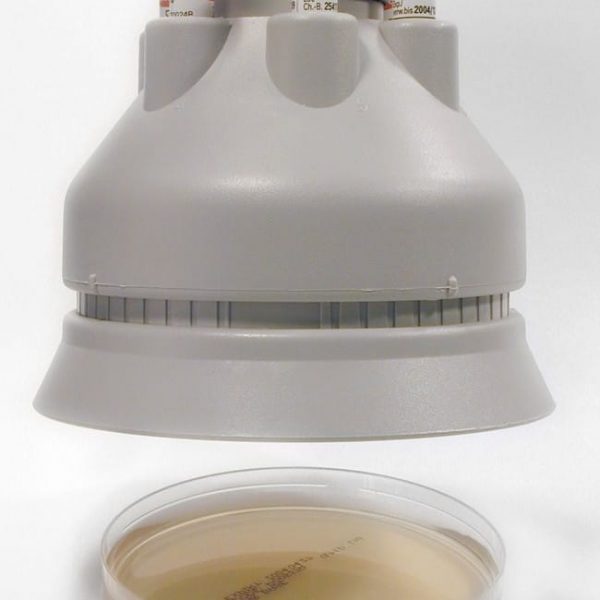
Dessicant Sachet
RM173.00Brand:
Thermo ScientificTM OxoidTM
Maintain a low moisture environment when storing AST products for manual Antimicrobial Susceptibility Testing with Thermo Scientific™ Oxoid™ Replacement Desiccant (Dispenser).
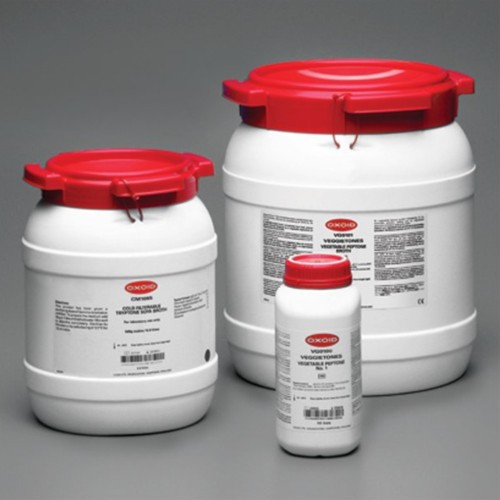
Dextrose Bacteriological 500g
RM150.00Brand:
Thermo ScientificTM OxoidTM
Oxoid Dextrose Bacteriological is a sugar suitable for inclusion in bacteriological culture media.

Dextrose Tryptone Agar 500g
RM737.00Brand:
Thermo ScientificTM OxoidTM
Oxoid Dextrose Tryptone Agar is used for detection and enumeration of thermophilic and mesophilic microorganisms in food.
Dextrose Tryptone Agar, Oxoid Composition
| Typical Formula* |
gm/litre |
| Tryptone |
10.0 |
| Dextrose |
5.0 |
| Bromocresol purple 1 |
0.04 |
| Agar |
12.0 |
| pH 6.9 ± 0.2 |
Dextrose Tryptone Agar, Oxoid Preparation:
Suspend 27g in 1 litre of distilled water and bring to the boil to dissolve completely. Sterilise by autoclaving at 121°C for 15 minutes.
Storage conditions and Shelf life
Store the dehydrated medium at 10-30°C and use before the expiry date on the label.
Store the prepared agar plates at 2-8°C.
Precautions
Incubation at 55°C must be carried out under humid conditions e.g. wrapped dishes or in a high humidity environment.

Dextrose Tryptone Broth 500g
RM707.00Brand:
Thermo ScientificTM OxoidTM
Oxoid Dextrose Tryptone Broth is used for detection and enumeration of thermophilic and mesophilic microorganisms in food.
Dextrose Tryptone Broth, Oxoid Composition
| Typical Formula* |
gm/litre |
| Tryptone |
10.0 |
| Dextrose |
5.0 |
| Bromocresol purple |
0.04 |
| pH 6.9 ± 0.2 |
|
Dextrose Tryptone Broth, Oxoid Preparation:
Add 15g to 1 litre of distilled water. Mix well and distribute into final containers. Sterilise by autoclaving at 121°C for 15 minutes.
Storage conditions and Shelf life
Store the dehydrated medium at 10-30°C and use before the expiry date on the label.
Store the prepared broth below 25°C.
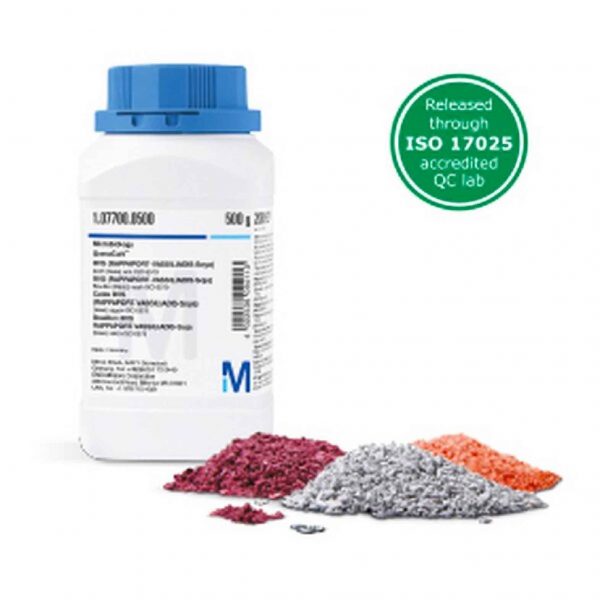
DG 18 (Dichloran Glycerol Chloramphenicol) Agar (Base), Merck
RM1,423.00Brand:
Merck
Description
This DG 18 (Dichloran glycerol chloramphenicol) agar (base) is tested according to ISO 21527 and FDA-BAM GranuCult®. DG 18 Agar is suitable to enumerate and isolate xenophilic moulds from dried and semi-dried foods such as dried fruits, spices, confectionery, cereals, nuts, and dried meat and fish products.

DGGE Package
Brand:
Cleaver Scientific
Denaturing Gradient Gel Electrophoresis (DGGE) is an important technique used in the search for mutations and DNA polymorphisms critical in genetic disorders and cancers, and to understand genetic diversity among species. The new OmniPAGE VS20WAVE-DGGE is a flexible system that can be fully customised to perform several different mutation detection techniques. The VS20WAVE-DGGE is a versatile single-unit solution for different single-base pair mutation detection methods. The newly designed VS20WAVE-DGGE is a complete system for DNA mutation analysis.
di-n-butylammonium methylammonium lead(II) heptaiodide – Sigma-Aldrich
RM2,191.00Brand:
Sigma-Aldrich
Synonyms
(BA)2(MA)Pb2I7, 2D perovskite, Bis(butylammonium) methylammonium heptaiododiplumbate
General Description
We are committed to bringing you Greener Alternative Products, which adhere to one or more of The 12 Principles of Greener Chemistry. This product has been enhanced for “Energy efficiency”.
Applications
2D perovskites have been used as the active material in may applications such as light emmiting diodes,[1] phototransistors,[2] and solar cells.[3] Unlike 3D perovskites, these layered materials give higher moisture stability and longer device lifetimes.
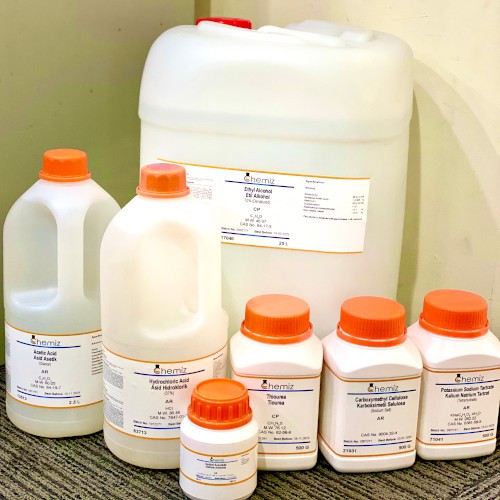
Di-sodium Hydrogen Phosphate Anhydrous, AR, 500g
RM28.00Brand:
Chemiz
Description
Synonyms: sec-Sodium phosphate, Disodium hydrogen phosphate, Disodium phosphate, Sodium hydrogenphosphate, Sodium phosphate dibasic
Formula: Na2HPO4
Disodium hydrogen phosphate anhydrous is typically used in the preparation of phosphate based buffer. The pKa of 6.82 at 25°C makes phosphate based buffer a universal buffer for biological applications.
Note:
AR: Analitycal Reagent Grade: Reagents for analytical purpose or research work that need high purity.
CP: Chemically Pure Grade: Reagents for regular practical in its original purity.

di-Sodium Phosphate Anhydrous for Analysis EMSURE® ACS,Reag. Ph Eur (Merck)
RM286.00Brand:
Merck
Description
CAS Number: 7558-79-4
Chemical Formula: Na₂HPO₄
Molecular Weight: 141.96 g/mol
Synonyms: di-Sodium Hydrogen Phosphate, Sodium Hydrogen Phosphate, Sodium Phosphate Dibasic
Quality Level: MQ300
Product Specification and MSDS for di-Sodium Phosphate (Merck).

Diagnostic Sensitivity Test Agar 500g
RM1,044.00Brand:
Thermo ScientificTM OxoidTM
Diagnostic Sensitivity Test Agar was developed in Oxoid as a dual purpose medium which would satisfy both diagnostic and susceptibility requirements.
Diagnostic Sensitivity Test Agar, Oxoid Composition
| Typical Formula* |
gm/litre |
| Proteose peptone |
10.0 |
| Veal infusion solids |
10.0 |
| Glucose |
2.0 |
| Sodium chloride |
3.0 |
| Disodium phosphate |
2.0 |
| Sodium acetate |
1.0 |
| Adenine sulphate |
0.01 |
| Guanine hydrochloride |
0.01 |
| Uracil |
0.01 |
| Xanthine |
0.01 |
| Aneurine |
0.00002 |
| Agar |
12.0 |
| pH 7.4 + 0.2 @ 25°C |
Diagnostic Sensitivity Test Agar, Oxoid Preparation:
Add 40 g to 1 litre of distilled water. Bring to the boil to dissolve completely. Sterilise by autoclaving at 121°C for 15 minutes.
For blood agar, cool the base to 50°C and add 7% of Defibrinated Horse Blood SR0050. Mix with gentle rotation and pour into Petri dishes (12 ml for a 9 cm dish) or other containers.
RECONSTITUTION AND MIXING SHOULD BE PERFORMED IN A FLASK AT LEAST 2.5 TIMES THE VOLUME OF MEDIUM TO ENSURE ADEQUATE AERATION OF THE BLOOD.
Storage conditions and Shelf life
Store the dehydrated medium at 10-30°C and use before the expiry date on the label.
Store the prepared agar plates at 2-8°C.
Precautions
Diagnostic Sensitivity Test Agar has reduced thymidine activity and this will affect its performance as a primary isolation medium.

